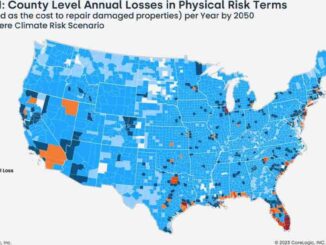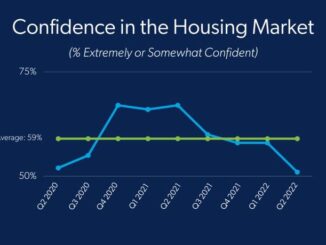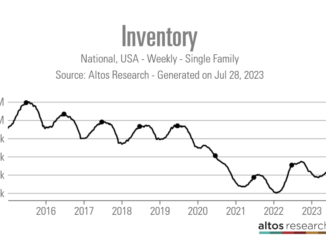It’s been a brutal 15-month period for the housing market since the Federal Reserve began escalating its benchmark interest rate in March 2022 to combat rising inflation.
Since then, the Fed has bumped rates 10 times, effectively putting the brakes on what had been a hot housing market. As the June 13-14 meeting of the central bank’s Federal Open Market Committee (FOMC) approaches, the housing industry remains prepared for yet another jolt of rate shock.
Many market observers, however, also remain hopeful the Fed will pause its rate-escalation strategy at the June meeting. The CME FedWatch Tool, which calculates probabilities for FOMC rate moves, shows as of this week there’s a 77% chance the Fed will hold rates at the current 5% to 5.25% range.
Meanwhile the jobs market remains robust as inflation continues to be well above the Fed’s target rate of 2% — with core inflation projected to run at an annualized rate of 3.8% in 2023, according to Fed staff.
Optimal Blue, a division of Black Knight, shows the interest rate for a conforming 30-year fixed mortgage stood at 6.733% as of June 6, up from 6.221% two months earlier. Meanwhile rate volatility, as measured by the Move Index, is down significantly in the wake of a deal reached in early June to raise the nation’s debt ceiling after a contentious battle in the U.S. Congress — going from an index score of 182.64 as of March 20 to 114.42 as of June 6.
What do all these seemingly conflicting signals mean for the housing market? Could we finally be at the bottom of the housing-market downturn and, if so, what will the new normal look like?
“I spoke at a conference in Miami a couple of weeks ago, and it was definitely top of mind,” said Fred Matera, chief investment officer at Redwood Trust, a real estate investment trust focused on the residential market. “You know, everybody wants to know where housing is at.”
With that pressing question in mind, HousingWire interviewed a range of players active in the primary or secondary mortgage markets to get their views on where the housing market is at and what likely lies ahead. Following are the key takeaways from those interviews.
Market forecasts
I would argue that we may be near trough origination volumes. From where we sit, we think that that improvement [for originations and related securitizations] materializes in the market more in the fourth quarter. … For house prices, I would still argue that there’s room for a little bit more to the downside, though probably not that much.
— Ben Hunsaker, portfolio manager focused on securitized credit for California-based Beach Point Capital Management
***
We may not be at the bottom, but we’re probably not far from it. … I think there is a lot of pent-up demand, and I think housing is going to be a positive surprise by the end of the year. And I also think it’s going to be in large part due to this very, very strong demand.
… If you look at [inflation] … there’s no easy answer or easy fix because it’s not linear and [the problem] was created by a slow response to address it, so it’s going to take an elongated time to squash it out.
In the meantime, the Fed only has a sledgehammer; they don’t have a scalpel, right? So, they’re just going to hammer you to death with these rates. Still, I happened to be in the camp that they’re going to pause [rate increases] at their June meeting. … Ultimately, I think mortgage rates will be lower by the end of the year.
— David Petrosinelli, a New York-based senior trader and managing director at InspereX, a tech-driven underwriter and distributor of securities that operates multiple trading desks around the country.
***
I think once the fog clears in like three to six months, and there’s just more directionality to where the economy and the Fed are going, that will give [borrowers] more confidence to step back in, and that sets up 2024 to be a better year for housing overall.
When we look at the data, investor-transaction volume tracks broadly with overall home sales, and we’re definitely seeing significant, like double-digit, declines in overall real estate volume, and I don’t think it is going to get back up by double digits. I do think there’ll be a normalization that happens over the next 24 months or so, depending on the trajectory of some of the macroeconomic data.
— Arvind Mohan, CEO of California-based Kiavi, a fix-and-flip, bridge loan and investment-property lender
***
We’re seeing big pent-up demand from [borrowers]. With any kind of pullback [in rates], we’re seeing people jumping in to try to buy a home. … We think we’re close to the bottom [of the down-market cycle].
… We’re structurally under-supplied with housing. … Most analysts say it’s anywhere from 3.5 million to 7 million housing units [including multifamily]. This lack of supply … is helping to keep prices elevated. And there’s not a lot of [home-sale] transactions, which is also supporting home prices.
… 3% mortgages are highly expansionary for the housing market. I’d say 4.5% to 5% is probably equilibrium. And 6% to 7% is constraining. If we get back down into the 5% range, I think it will spur more activity, and you’ll see more people moving and trading up.
[For now, as a mortgage lender] you just need to look at your business and right-size for the appropriate amount of origination volume.
— Fred Matera, chief investment officer of California-based Redwood Trust
***
If you’re in mortgage land, you’re in survival mode now. … This is maybe the darkest part of the night, right? By the end of the summer, I think it’s brighter only in that I think we can say that rates will have peaked. … It ain’t going to be a big number up [in origination volume], but we should start to see kind of an incremental improvement.
… If we can achieve a true soft landing [for the economy], which it looks like we might be able to pull off, then … rates will start to kind of slowly go down. For the housing market, this is the bottom; we’ll get past this. But it’s not a slam dunk, don’t get me wrong. Nobody’s doing backflips here. Nobody’s doing high-fives. Nobody’s saying, “Hey, let’s break out the steaks and put away the hotdogs.” You know, it’s just incremental. … We need to see a 200 basis-points drop [in rates] before you see any meaningful refinance business.
… Volume is challenged, but in what context? If you look at the last 20 years, a $2 trillion dollar mortgage market is a pretty normal market. I know everybody was hooked on the cocaine that was 2021 and 2022, and we all love $4 trillion markets, but come on. … Around $1.5 trillion is probably the new normal.
— John Toohig, based in Memphis, is a managing director at Raymond James, a board member and president of Raymond James Mortgage Company Inc. and head of the Whole Loan Trading Group
***
In March of 2021, the industry was running at a $4.4 trillion annualized pace [for origination volume]. You’re down nearly 75 from that level. … I think it’s $1.2 trillion to $1.4 trillion market this year because I do think the back half of the year will be a little better. That’s still a nuclear winterish kind of volume, especially for the current size of the industry. The industry has not shrunk 75%, not yet. … There’s 27% fewer originator licenses according to NMLS, so originators have shrunk a little less than a third, but companies haven’t shrunk by 75%.
I don’t think the path to normalcy is going to be a straight line. I think we’re going to have some bumps [along the way]. So, I think [mortgage lenders] need to be really thoughtful and prudent and not think the disease is gone now and that we’re back to good times — or even something that approaches normalcy, yet.
I don’t mean to sound overly bearish. But people are looking in the rearview mirror in history and think, “Oh, well, it’s got to fix and return to the mean.” No, it doesn’t.
— Brian Hale, founder and CEO of California-based consulting firm Mortgage Advisory Partners LLC
***
We are going to continue to see, I believe, a stabilization of the value of homes in the single-family home market, and that is going to give investors, homebuyers and homebuilders a lot of confidence. … I believe that people will find a way, if they need to live in a home, or they want to live in a home, they will find a way to pay for a mortgage in the 6% to 7% range. But it all starts with solidification in the foundation of housing values. And I think that we’re starting to come out of the period where people we’re fearful of a continual downward slide in housing prices.
I also believe there will be greater demand from borrowers in the back half of 2022 because I think that there’s going to be a growing narrative this summer about how the housing market has stabilized. That will drive a lot of millennial first-time homebuyers … to come off the sidelines and say, “OK, now’s the time.”
… I believe that we are starting to come out of the bottom [of the market] and so long as it remains a stable interest-rate lending environment, and homebuyers start to feel like housing [prices] have bottomed and are really beginning to rise, then I think they will get increasingly comfortable with the current mortgage-rate environment. That will start the machine back up across all of lending and across all residential investment.
— Ryan Craft, founder and CEO of Saluda Grade, a New York-based real estate advisory, securitization and asset-management firm specializing in alternative lending products in the nonbank sector



